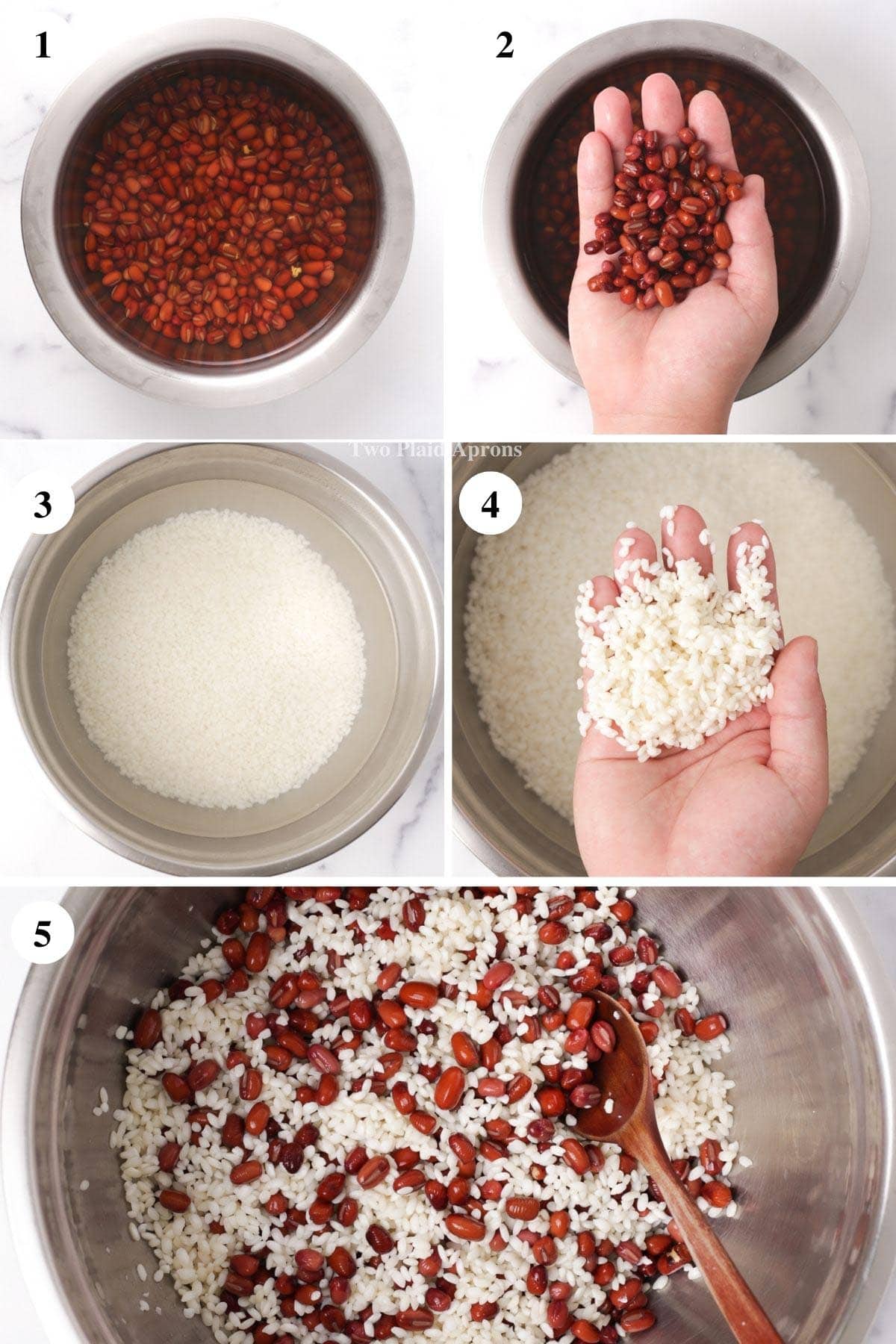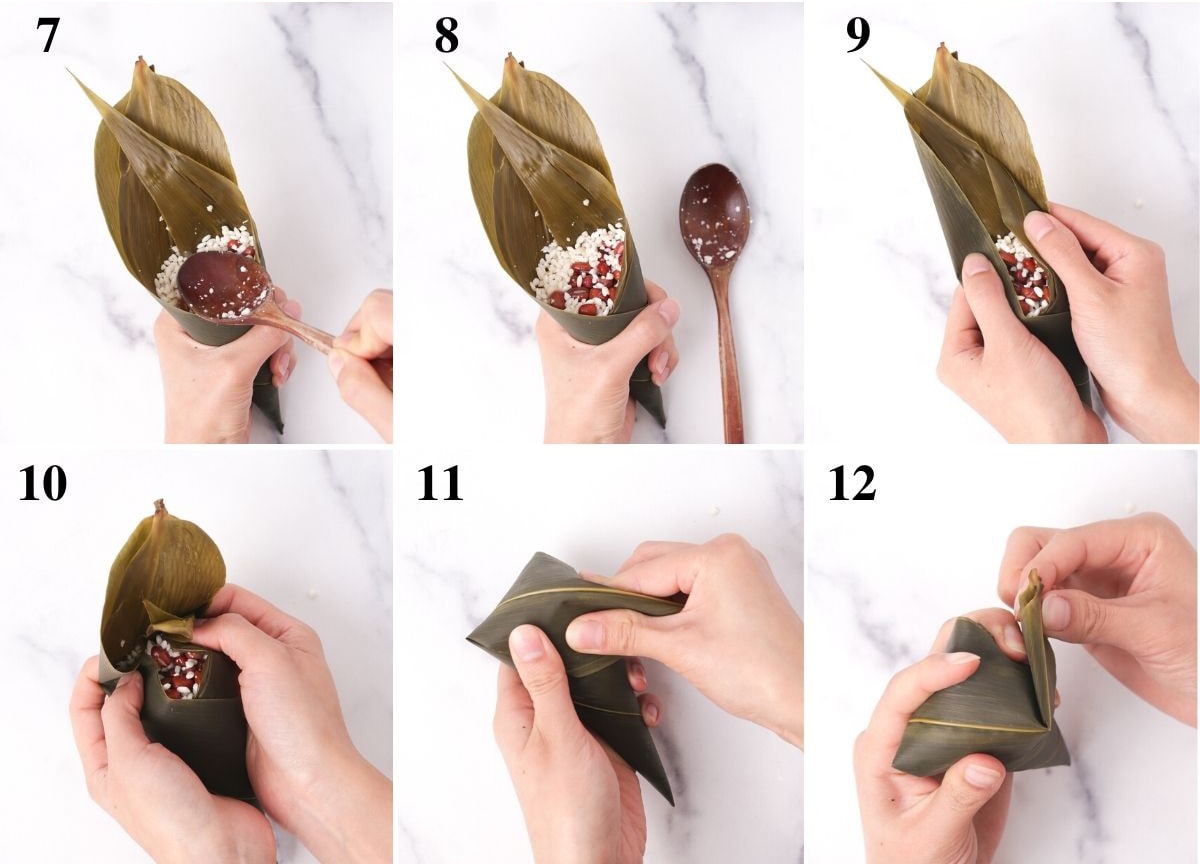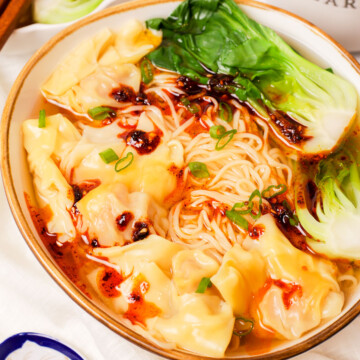These red bean zongzi, also known as sticky rice dumplings, are a treat enjoyed during Dragon Boat Festival. They are delicious with a some honey or sugar. For a savory version, also try our Cantonese-style zongzi. Our post below includes step-by-step-photos with detailed instructions so that you can make it with ease, even if you are a beginner.

My grandparents grew up in the Fujian Province in southern China, where jianshui (akaline zongzi) and sweet zongzi are the most popular. The rice dumplings are sometimes plain with only glutinous rice, or mixed with peanuts, dates, grains, and/or beans.
These sweet zongzi are amazing rolled in some sugar or drizzled with some honey! They're practically desserts, and a dessert that you're allowed to have for breakfast.
So, follow along our step-by-step instructions with photos to learn how to make this beginner friendly zongzi with red beans!
If you're looking for more Asian dessert recipes, you may so like our Hong Kong mango pancake, mango coconut sago, and black sesame tang yuan (glutinous rice balls).
If you’ve made this recipe or any recipes from our blog, please tag us on Instagram using #twoplaidaprons! You can also tag us in your Instagram stories using @two_plaid_aprons. We would love to see your creations! It absolutely makes our day! 🥰
Jump to:
What is zongzi?
Zòngzi (粽子) are Chinese sticky rice dumplings made with glutinous rice and various fillings, wrapped in bamboo leaves. You would often find these sticky rice dumplings offered in both sweet and savory options. For this recipe, we are making sweet zongzi with red beans (azuki beans).
We make sticky rice dumplings every year for Duān Wǔ Jié (端午节), more commonly known as Dragon Boat Festival. It's a festival to commemorate the death of Qu Yuan, a famous poet and minister that falls on the 5th day of the 5th month on the lunar calendar.

Types of zongzi
There are plethora of zongzi variations from different fillings to folding style. But generally speaking, zongzi are separated into two categories:
- Sweet - Usually filled with beans, nuts, black rice, red bean paste, and/or dates.
- Jianshui zongzi - This is a subcategory of sweet zongzi. The glutinous rice for these zongzi are mixed with a small amount of alkaline solultion to turn the rice yellow.
- Savory - The rice for these rice dumplings are usually either seasoned with just some salt or mixed with soy sauce, dark say, and some oil for color and flavor. The fillings are usually, marinated chicken or pork, shiitake mushrooms, salted egg yolk, Chinese sausage, and/or sometimes mung beans, like our cantonese-style savory rice dumplings.
Ingredients
Please scroll down to the recipe card for the ingredient quantities!
- Glutinous white rice - Also known as sweet rice. Don't be alarmed by the name "glutinous"! It's totally gluten free. Rather, "glutinous" refers to the chewy, mochi-like texture the rice have. We prefer short grain glutinous white rice, like this one from Koda Farm.
- Azuki beans - These are also known as red beans. Azuki beans are used to make red bean paste for classic red bean buns to trendy pastries like our wool bread with red bean paste.
- Dry bamboo leaves - You can usually find dry bamboo leaves at your local Asian market, near the aisles where dry noodles, herbs, dry produce, and nuts are found. If you get lucky, you may even find fresh bamboo leaves sold in vacuum packs.

Ingredient preparations
For the glutinous rice and red azuki beans:
In each their own bowl, soak the rice and beans for at least 6 hours or overnight in the fridge, covered. After soaking, rinse the rice a couple of times to get rid of excess starch and drain well. Drain the azuki beans and add it to the soaked rice. Give it mix to roughly distribute the rice and beans. Set aside until needed.

For the bamboo leaves:
1. In a large bowl or pot, soak the bamboo leaves for at least 6 hours or overnight in the fridge. You can curve and gently bend the leaves so that they fit in your bowl or pot. If needed, place a bowl/plate on top of the leaves to keep them submerged in the water.
🌟 Pro tip: You can tell the leaves are ready to use when they turn darker green and looks rehydrated. The leaves will also feel much more flexible.
2. After soaking, use a wet, clean dish towel or soft sponge to clean both sides of each bamboo leaves by gently wiping each side. Repeat with all of the bamboo leaves, then give them a final rinse.
3. Keep the bamboo leaves in a bowl of water until needed, to prevent the leaves from drying out. When ready to use, drain the leaves

How to wrap Chinese zongzi (cone shaped)
This zongzi wrapping method is called the "horn" fold, creating sharp cone shaped rice dumpling. We find this one to be very beginner friendly, and great for zongzi that doesn't have large chunky fillings like meat.
Form the cone:
1. Layer two bamboo leaves on top of each other, shiny side up. Try to keep the thick stem ends lined up. You can use two similarly sized leaves or one long one short. The purpose is simply to reenforce the bamboo leaves.
2. Starting around the middle of the bamboo leaves, twist the leaves inwards to create a cone.
3. Twist the leaves to tighten the cone so that the bottom is pointy and completely closed. If you look into the cone, you shouldn't see any light through the bottom.
📝 Note: After the cone is formed, the tail ends of the bamboo leaves should be in the front and the stems should in the back.

Fill the cone and finish the fold:
6. With the cone's opening facing towards you, spoon some rice and azuki bean mixture into the cone and poke with a chopstick to ensure that the rice gets packed into the tip of the cone.
7. Spoon in more rice and red beans until it reaches the opening of the cone. Use the back of the spoon to pack the rice in. The top of the rice and beans should be relatively flat.
8. With your thumbs, fold the sides of the cone inwards. While still holding onto the sides, fold the back flap down.
9. Use one hand to hold down the flap and your other hand to pinch the flap close. Fold the flap either to the left of right side of the cone and tightly hold on to the zongzi and the flap.

How to tie up cone shaped zongzi
1. Hold the cone shaped zongzi with 3 main fingers: your thumb on the left, pointing finger on top, and middle finger on the right. If you are left handed, it would be the opposite.
2. Hold on to one end of the butcher's twine with the middle finger holding the zongzi. Leave a tail of about 5 to 6 inches. This will later be used to tie the twine togther.
3. Wrap the working end of the twine over the top of the rice dumpling and down to the thumb. Use your thumb to hold onto the twine, and continue wrapping the twine behind the cone and up to the middle finger. Repeat around once more, then pull on the working end of the twine to tighten.
4. Next, tie the tail end of the twine to the working end. Then, tie it again, but like how you would tie your shoelace. This will secure the rice dumpling without creating a dead knot.
5. Trim the flap with the stem if needed, if it's sticking out. Repeat with remaining fillings and leaves.
6. Once all of the zongzi has been wrapped, collect the long ends of the twine and tightly knot them together. This will make it easier to pick up all of them up at once.

2 ways to cook zongzi (Instant Pot and stovetop method)
Traditionally, Chinese rice dumplings are simmered on the stovetop for several hours. But if you have a pressure cooker, like an Instant Pot, it'll cut the cook time down to less than 30 minutes!
For the stovetop method:
1. Bring a large pot of water to a boil. Make sure there's enough water to fully submerge all of the zongzi.
2. Place the sticky rice dumplings into the boiling water and bring it back up to a boil. Then, reduce the heat to let the rice dumplings gently simmer. Cover the pot with a lid and let the rice dumplings simmer for about 2 ½ to 3 hours, or until the rice and azuki beans are cooked through.

For the Instant Pot method:
1. Place the zongzi in the Instant Pot, then fill the pot with enough water to fully cover all of the rice dumplings or to the max line.
2. Replace the lid and close the Instant Pot. Also, switch the steam vent to "SEAL".
3. Select the pressure cook setting and let the sticky rice dumplings cook on high pressure for 30 minutes. Once the time is up, let the Instant Pot natural release for about 10 to 15 minutes, then manually release the rest of the steam. Use a chopstick or spoon. It'll be very hot, so be careful!

Recipe tips
- Prepare a few more bamboo leaves than needed. Sometimes the bamboo leaves will tear, so prepare extras for just in case. If this is your first time making zongzi, it's good to have several extra leaves for practice.
- Wrap and secure the zongzi tightly to prevent water from leaking into the rice. This will give you the best glutinous rice texture that's sticky and chew.
- Prepare all the ingredients and equipments before you start wrapping the sticky rice dumplings. For example, precut all the butcher's twine to about 36 inches, so you can go straight into tying up the dumplings.
- Poke with a chopstick to ensure the tip of the rice dumpling is packed with rice. This will give you a beautiful, pointy zongzi when you unwrap it.
- Tie the butcher's twine onto an anchor for easier tying. This is especially helpful when making zongzi by yourself. You can bundle up the twine and tie them to the kitchen sink faucet or oven handle. Just add a few more inches to each piece of twine.

How to serve red bean zongzi
To serve these sweet zongzi with red beans, simply untie them from the butcher's twine after they have cooled a little. Then, unwrap the rice dumpling according to the folds on the bamboo leaves.
You can serve the red bean zongzi straight on the bamboo leaves or transfer it onto a place. Enjoy the sticky rice dumplings with your desired amount of honey or plain white sugar. These zongzi are also great with some hot tea.

Storage
Once the red bean zongzi are completely cooled, store them in airtight containers or plastic bags. You can keep them in the fridge for up to 3 to 4 days or frozen for up to 2 to 3 months. Make sure to keep the butcher's twine intact for storage. This will keep the rice dumplings neatly together.
Reheating
You can easily reheat zongzi in the microwave. Just place the whole rice dumpling into the microwave and heat until hot. Untie the twine and enjoy.
You can also reheat the zongzi by steaming or boiling. Sticky rice dumplings that have been frozen benefit from this method. Once the rice dumplings have defrost, boil them for about 5 minutes or steam for about 15 minutes, until heated through.

FAQ
Zongzi, or sticky rice dumplings, are eaten on and around Dragon Boat Festival. This holiday falls on the 5th day of the 5th month in the lunar calendar. That's usually during late May or mid June in Gregorian calendar.
Zongzi are offered in both sweet and savory options. The rice itself is quite light in flavor but is sticky and chewy. The filling is usually what gives the flavor, especially for savory ones. Sweet zongzi are usually accompanied with sugar or honey.
Traditionally, zongzi are cooked on the stovetop at a gentle simmer for at least 3 hours. If using a pressure cooker, like Instant Pot, the cook time can be less than 1 hour!
Sticky rice dumplings are best eaten warm. This way you'll be able to enjoy the nice chewy texture of the rice and the fill flavor of the rice dumpling. Also, it is best to eat glutinous rice hot or warm to prevent indigestion.
📖 Recipe
Zongzi with Red Beans
Ingredients
- 2 cups short grain glutinous rice (also known as sweet rice)
- 1 cup dry azuki bean (also known as red beans)
- 24 dry bamboo leaves
- Sugar or honey on the side for sweetening
Instructions
Prepare the ingredients:
- Soak the glutinous rice, azuki red beans, and bamboo leaves, each in their own bowls, for at least 6 hours or overnight in the fridge.
- After soaking, drain the glutinous rice and give it a couple of rinses to get rid of excess starch. Drain the azuki beans and add it to the glutinous rice. Give it a mix to roughly distribute the beans.
- For the bamboo leaves, drain the water and use a clean dish towel or soft sponge to gently wipe down both sides of each leaf. Repeat with all the leaves, then give them a final rinse. Keep the leaves in a large bowl of water until ready to use to prevent them from drying out.
Make the Zongzi (sticky rice dumplings):
- Assemble your zongzi wrapping station by preparing 12 pieces of butcher's twine, each about 36 inches long. Drain the bamboo leaves and have the glutinous rice and beans near you. Also prepare a chopstick and a spoon.
- Follow the step-by-step photos and instructions in the post above to wrap the zongzi. Make sure to secure the butcher's twine tightly around the wrapped zongzi so that water doesn't enter the rice dumpling while cooking. After securing the rice dumpling, you can cut off the extra stem that sticks out.
- Once all the sticky rice dumplings have been assembled and tied, collect them by the leftover butcher's twine. Tightly knot the twines together for easy handling.
Instant Pot method:
- Place all the zongzi into the inner pot of the Instant Pot and fill it with enough water to cover all of the rice dumplings or up to the max line. Close the lid on the Instant Pot and secure the vent nozzle to "SEAL".
- Select the "pressure cook" option and let the rice dumplings pressure cook on high for 30 minutes.
- Once the time is up, let the Instant Pot natural release for about 10 minutes. Then, manually release the remaining steam. It'll be VERY HOT so be careful! Use a chopstick or spoon to help release the steam.
- Carefully remove the rice dumplings using the knot created and set aside to let cool.
Stovetop method:
- In a large pot, fill it with enough water to completely cover all of the rice dumplings. Bring the water to a boil.
- Gently place rice dumplings into the boiling water and let it come back to a boil. Then, reduce the heat to keep the water at a gently simmer with the lid on. Let the rice dumplings simmer for about 3 hours, or until the rice and the azuki beans are cooked through.
- Carefully remove the rice dumplings out of the pot and set them aside to let cool.
Serve the zongzi:
- Once the rice dumplings have cooled down a little, untie however many you are eating. Unwrap the zongzi by following the folds. Enjoy the zongzi by dipping in some sugar or drizzled with some honey.
Notes
- If this is your first time making zongzi, you may need more time to wrap, but as you get a couple practices in, you will become faster at it.
- Bamboo leaves - Dry bamboo leaves are much more accessible than fresh leaves. For dry leaves, you must soak them to rehydrate and then clean them before use. If you find fresh bamboo leaves, you can skip the soaking step, but depending on how they are packaged, you may need to clean and rinse them.
- Soaking - For all of the ingredients, if only soaking for about 6 hours, you can leave it out. However, if the weather is really warm or if you want to soak the ingredients overnight, please cover and put them in the fridge.
- Butcher's twine - If you prefer, you can bundle up the butcher's twine and tie them onto an anchor like your oven door or kitchen sink faucet. This will allow you to create some tension on the twine so that it's easier to make knots.






















Comments
No Comments